Project
SUNFLOWER
Sustainable Near-net-shape Fabrication of Low Environmental impact Receiver materials
Acronym
SUNFLOWER
Duration
11/2023 – 10/2026
Project objectives
Concentrated Solar Power (CSP) can play a relevant role in the renewable energy sector providing cost effective energy storage solutions that support higher shares of non-dispatchable renewables while stabilizing the electricity grid. CSP plants using air as heat transfer fluid (HTF) offer important advantages, including high conversion efficiency, low cost of thermal energy storage, and potential for integration with compressed air energy storage (CAES) systems.
This project focuses on the analysis and optimization of novel air-based hybrid CSP-CAES plants, with open volumetric air receiver (OVAR) technology. The performance of OVAR absorbers depends on the interaction between material properties, structural design, and preparation techniques. Therefore, the SUNFLOWER project targets the following interconnected specific objectives:
Optimization of raw material processing
The project prioritizes Iron-Chromium-Aluminium-alloys (FeCrAl) and Silicon Carbide (SiC) due to their exceptional high temperature properties. However, improvements in raw material processing are necessary to minimize environmental impacts.
Optimization of absorber structure design
The project will define the system integration layout and support pre-engineering efforts, with two innovative approaches:
a) Development of tailored static volumetric absorber structures for novel power cycle architectures combining CSP technology with CAES;
b) Evaluation of a novel active high-flux OVAR concept, introducing absorber rotation to achieve up to 1000 suns mean concentration ratio (≈1 MW/m² mean flux), and peak fluxes up to about 4.5 MW/m². SUNFLOWER will push this novel rotating absorber technology a step further (at TRL 4).
Absorber material improvement
The project aims to enhance material durability under OVAR application conditions:
a) FeCrAl alloy: Improved surface passivation via an Alumina-layer, realized by the addition of Aluminium; rapid temperature change resistance by Yttrium addition; and enhanced temperature stability with Nickel incorporation.
b) SiC: Enhanced densification of the microstructure during sintering through optimized particle size distribution and process adjustments.
Absorber fabrication improvement
The fabrication of open-cellular absorber structures with high surface area (high functional porosity) and low strut thickness is currently at technology readiness level 3 (TRL3). The project seeks to improve the preparation techniques:
a) FeCrAl: Powder Bed Fusion – Electron Beam Melting;
b) SiC: Replica technique.
These improvements aim to achieve high densification, defect-free structures, mechanical strength, and oxidation resistance.
Testing and overall assessment
To validate the absorber designs and material improvements, intensive application-related tests will be performed. Lab-scale tests using a solar simulator at CIEMAT (1-3 kW thermal) and operating temperatures up to 900 °C will complement numerical evaluations. These tests will provide critical data for life-cycle and performance assessment, guiding further development and optimization.
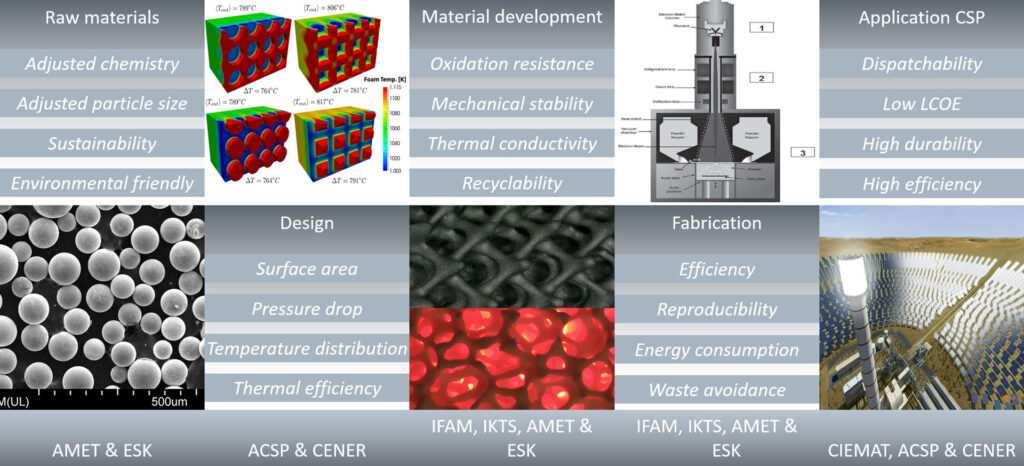
Project partners and corresponding funding agency
The project is connected to the Clean Energy Transition Partnership Joint call 2022 (CETP 2022) and therefore Co-funded by the European Union as well as the national funding agencies.


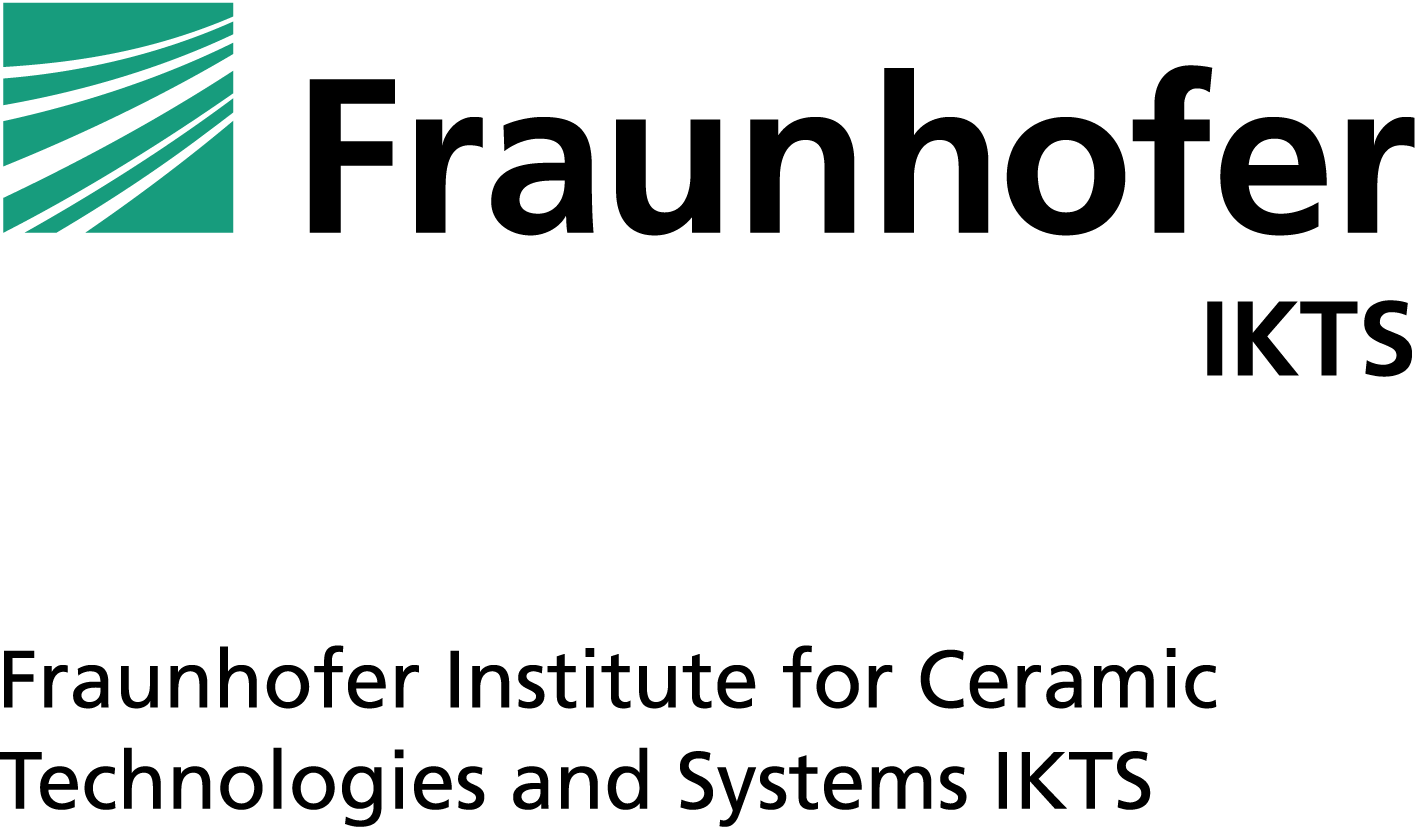
Fraunhofer IKTS
Germany
Project Coordinator
Germany/Saxony region – Saxon State Ministry for Science, Culture and Tourism – SMWK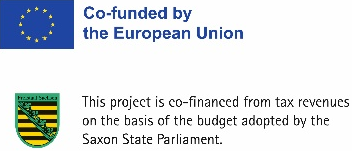
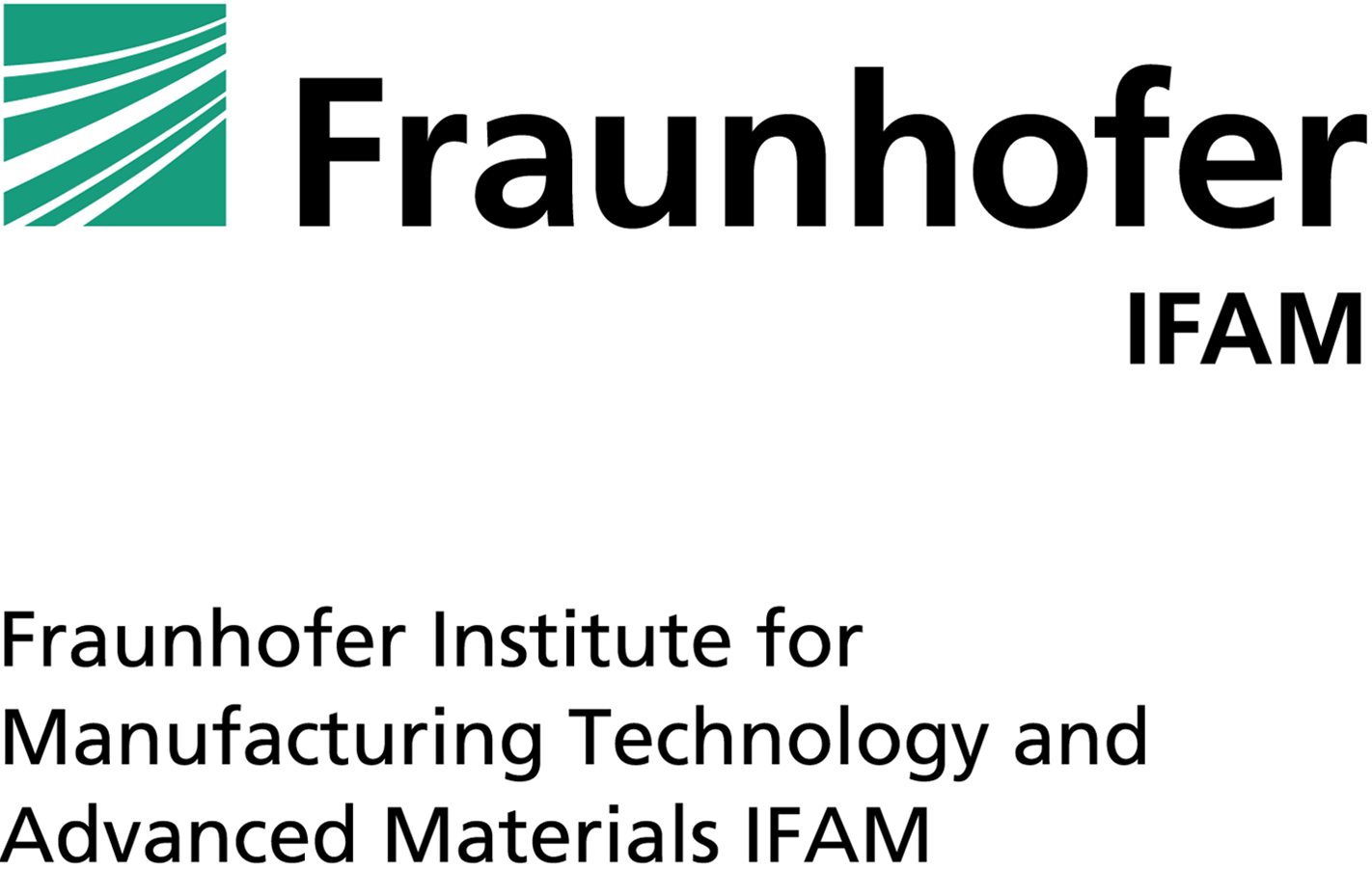
Fraunhofer IFAM
Germany
Partner
Germany/Saxony region – Saxon State Ministry for Science, Culture and Tourism – SMWK

Amazemet PS. Z O.O.
Poland
Partner
Poland – National Centre for Research and Development – NCBR
AALBORG CSP AS
Denmark
Partner
Denmark – Innovation Fund Denmark – IFD![]()
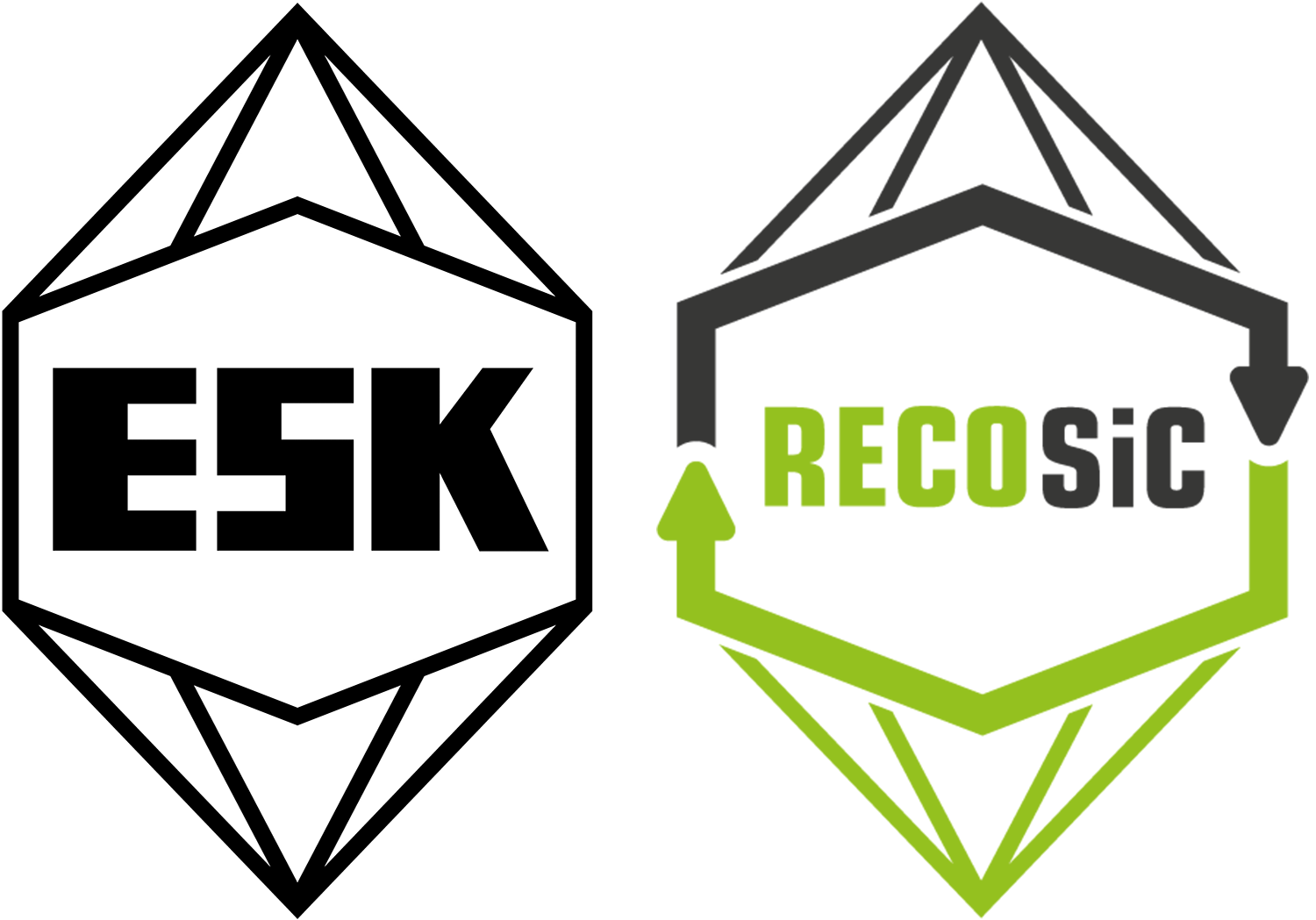
ESK-SIC GmbH
Germany
Partner
Germany/North Rhine-Westphalia region – Forschungszentrum Jülich GmbH (MWIKE) – FZJ/PtJ

Centro de Investigaciones energéticas Medioambientales y Tecnológicas
Spain
Partner
Spain – Agencia Estatal de Investigación – AEI

FUNDACION CENER
Spain
Associated Partner
Self-funded
Current project status
News from Aalborg CSP
ACSP is the responsible for the design and evaluation of the innovative receiver structures based on a techno-economical analysis and concept development for upscaling and commercialization. In particular, ACSP has during this first year been leading WP3 that covers different important aspects. The work package and individual tasks aims to model optimal solar absorber structures for improved thermal efficiency. Two design concepts have been explored: static absorbers and innovative rotary absorbers. Tasks included designing FeCrAl and SiC-based receiver structures, as well as conducting technoeconomic analyses for upscaling.
The tasks of WP3 is progressing according to plan and Task 3.1 and 3.2 will be finalized in the end of year 2024. In WP6 – task 6.5 ACSP has developed a framework for the economic, environmental and social assessment process. This is to be distributed and used by all partners in the project, to secure that all intended and unintended effects of the development are considered.
News from AMAZEMET
For the preparation of iron chromium aluminium alloys that will be investigated within the project, AMAZEMET chose the so-called rePOWDER system equipped with a focussed plasma torch and an arc melting process. A first set of powders has been prepared and shipped to Fraunhofer IFAM for the preparation of flat test specimen.

News from ESK-SIC GmbH
The task of ESK-SIC GmbH within the project is to produce sinterable SiC powder from recycled material. For this purpose, internal filter dusts were thermally treated using the patented RECOSiC process. This allows typical impurities such as SiO2, free silicon and carbon as well as iron to be reduced. The recycled filter dusts are then ground into a sinterable powder. With the appropriate processing unit (attritor mill), a grain size in the sub-µm range can be achieved. Three sinterable SiC powders were produced, which differ in their specific surface area (10, 13 and 15 g/cm2). The powders made from recycled SiC achieve the quality of the standard material. The first step towards sustainable SiC-based recievers has thus been achieved.

News from CIEMAT-PSA
During the first year of the SUNFLOWER project, CIEMAT-PSA made significant contributions to WP3 and WP5. In WP3, numerical simulations focused on a metallic wire mesh configuration to study the effects of geometrical properties (porosity, wire diameter) and operational parameters (velocity, solar flux). A comprehensive analysis has been completed, and an article is currently under review. Additionally, building on the CAPTure project, a more complex receiver geometry based on silicon carbide (SiC) foam was studied. This geometry shared similar properties, including porosity, cell size, strut diameter, and was validated with less than 10% deviation between experimental and numerical results. The validated geometry will now serve as the basis for exploring other geometrical factors.
In WP5, CIEMAT-PSA upgraded the Accelerated Solar Aging Test Bench (AATB) to simulate operational conditions for ceramic and metallic samples. Preliminary tests were conducted on SiC (ceramic) and FeCrAl (metallic) alloys, both in pre-oxidized and as-sintered states. A one-year equivalent aging test was performed using the 40 kW Solar Furnace (SF40), with optical properties measured before and after testing. The results revealed that:
- Pre-oxidized samples demonstrated better optical properties compared to as-sintered.
- As-sintered samples improved to match oxidized samples properties after one year of equivalent solar testing.
- FeCrAl alloys demonstrated good absorptance and emittance, while SiC needs further study.
- Among the tested ceramic materials, the SiC S239 recipe had the best optical properties and is recommended for further application.
- For metallic samples, the pre-oxidized aF_6607 sample performed the best.
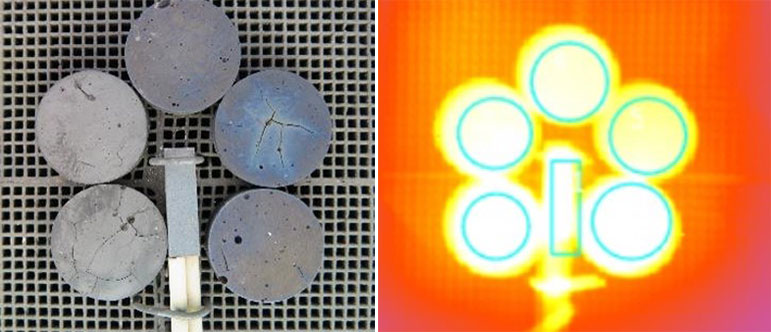
News from CENER
CENER has designed and built a lab-scale active volumetric solar absorber composed of rotating discs with radial cuts as shown in the following figures:
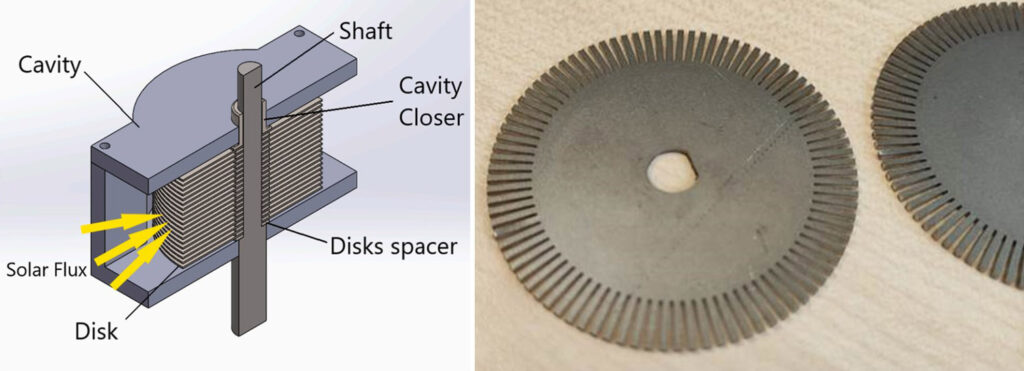
Start of the experimental testing is planned for the beginning of 2025 at CIEMAT.
News from Fraunhofer IFAM
Within WP1 the target chemical compositions for powder atomization were defined. Powders were compacted to cylindrical test specimen using spark plasma sintering (SPS). These test samples were partially conditioned by oxidation. Specimen will be characterized after solar furnace test.
Based on this in WP3 absorber structures with graded Voronoi lattices were additively manufactured by electron beam powder bed fusion (PBF-EB). They will be used for gas permeability measurement and calibration of the Computational Fluid Dynamics model.
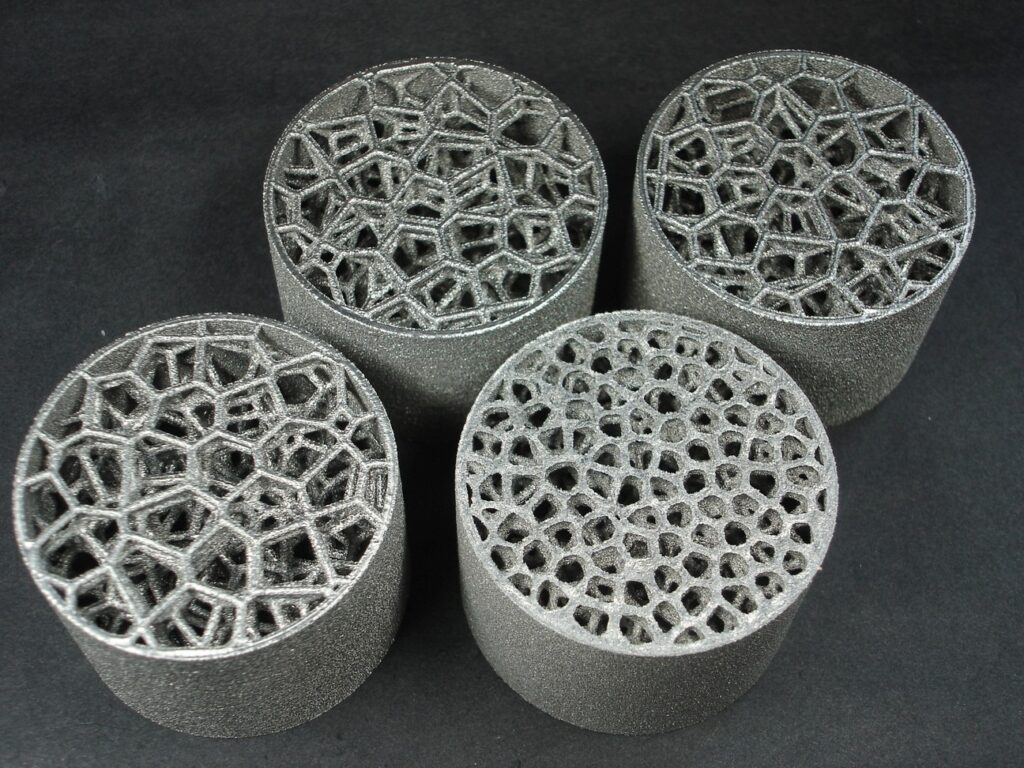
News from Fraunhofer IKTS
Within the first project year IKTS focussed on the microstructural improvement of SSiC with respect to the process limitations for open-celled absorber structures made by replica technique. Part of WP2 was the investigation of the sintering behavior of reyceled SiC-powder prepared and provided by ESK and the preparation of first flat test specimen for the Accelerated Solar Aging Test at PSA.
In WP4 first investigations were performed for the improvement of the process technology for the preparation of open-celled SiC absorber structures with high mechanical stability and low oxidation rate. Aside of foam templates also 3d-printed polymeric, graded, Voronoi structures have been tested.
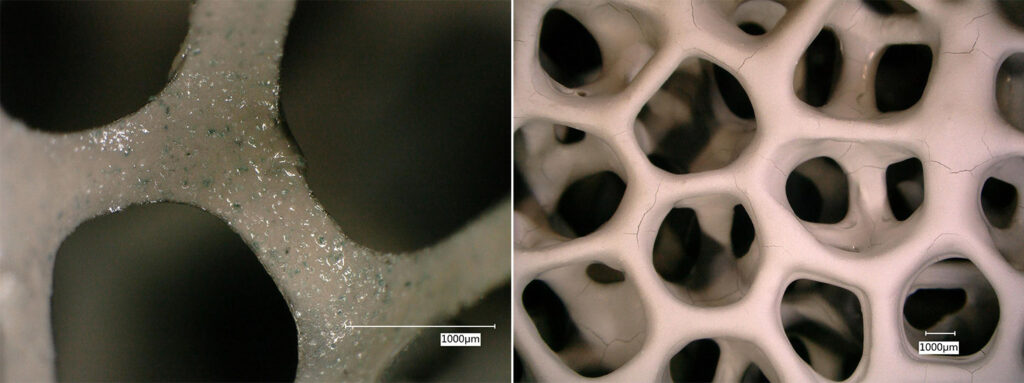
Dissemination
- Deliverable 1 – Definition of material requirements and specifications of raw materials – finished
- Deliverable 2 – Basic material development for FeCrAl and SiC flat test specimen – finished
- Deliverable 3 – Material assessment based on flat specimen test in solar furnace – finished
Publications
- Lecture given by Antonio Luis Ávila-Marín at SolarPaces 2024 in Rome: “CFD analysis of an open volumetric air receiver and comparison with a 300 kWth solar receiver tests”
- Lecture given by Alexander Fuessel al CellMAT 2024 in Magdeburg, “Development of open-celled absorber structures for open volumetric air receiver in concentrated solar power plants”
